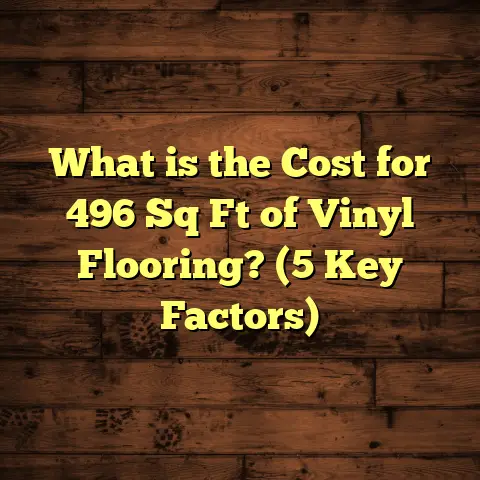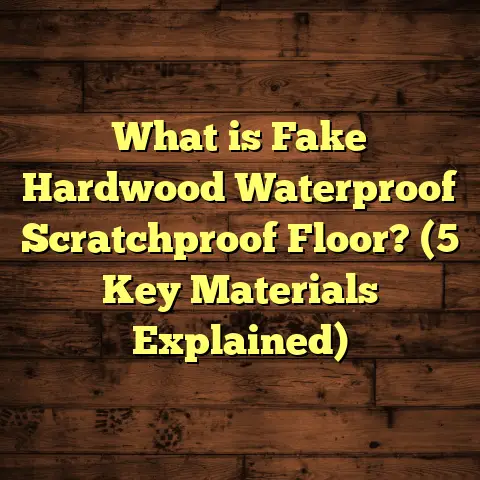What is Mil in Vinyl Flooring? (5 Key Benefits Explained!)
Misconceptions about vinyl flooring often swirl around its durability and quality.
Many people assume all vinyl floors are thin, cheap, and easily damaged.
But in my years working with clients and handling countless flooring projects, I’ve learned that a key factor often overlooked is the “mil” rating in vinyl flooring.
This small measurement packs a big punch in how vinyl performs over time.
What Is Mil in Vinyl Flooring?
Let’s get straight to it. What exactly is a mil when talking about vinyl flooring?
A mil is a unit of measurement equal to one-thousandth of an inch (0.001 inch).
When you hear someone say a vinyl floor is “20 mil,” they’re describing the thickness of the wear layer—the clear protective surface on top of the vinyl.
This wear layer is like the vinyl’s armor, protecting it from scratches, dents, stains, and fading.
The thicker the mil, the tougher and longer-lasting that armor tends to be.
For example:
- A 6 mil wear layer is common in residential vinyl flooring that sees light traffic.
- A 20 mil wear layer or more is often used in commercial settings or heavy-traffic areas.
When I first started recommending vinyl flooring, I noticed many homeowners didn’t understand why this number mattered so much.
They’d pick floors based on color or pattern alone, then wonder why their floors showed wear after just a year or two.
Once I explained the role of the mil, their approach to choosing vinyl changed completely.
Why Thickness Matters
The wear layer thickness controls how resilient your floor will be against daily life—kids running around, pets scratching, furniture sliding.
Too thin, and the floor might look great day one but quickly show damage.
Thick enough, and the floor can stay looking fresh for a decade or more.
Here’s some data from industry sources that I found telling:
- Vinyl floors with a 12 mil wear layer last about 7 years in medium-traffic homes.
- Floors with 20+ mil wear layers can last 15 years or more under similar conditions.
These numbers match what I’ve seen professionally.
Breaking Down the Vinyl Floor Structure
To fully appreciate what mil means, it helps to understand what makes up a vinyl floor.
Typically, vinyl flooring consists of several layers:
- Backing Layer: The bottom layer that provides stability and support. Sometimes made of felt or fiberglass.
- Core Layer: Provides thickness and durability; can be rigid (WPC or SPC cores) or flexible.
- Design Layer: The printed image that gives the vinyl its look—wood grain, stone pattern, or tile design.
- Wear Layer: This is where mil comes into play—the transparent protective coating on top.
The wear layer’s thickness varies depending on the product grade and intended use. It’s usually measured in mils because this tiny unit offers precision in manufacturing specs.
Mil vs Total Thickness — What’s the Difference?
You might have noticed that vinyl flooring products often list both total thickness (like 4mm, 5mm) and wear layer thickness (like 12 mil).
They’re related but different metrics.
- Total thickness includes all layers combined (backing + core + design + wear).
- Mil rating refers only to the wear layer thickness.
It’s possible for a vinyl floor to be quite thick overall but have a thin wear layer—this usually means more comfort but less durability at the surface.
In my experience, focusing on wear layer mil thickness is key if longevity and resistance are your priorities.
5 Key Benefits of Considering Mil in Vinyl Flooring
Let me walk you through the main benefits of understanding and choosing the right mil for your vinyl floor.
1. Longevity and Durability
One of the biggest benefits I’ve seen firsthand is how wear layer thickness extends a floor’s life.
In one project for a family with young kids and pets, we installed vinyl with a 20 mil wear layer in their kitchen and living room.
Three years later, the floor still looked brand new despite heavy use—no scratches or dull spots.
The thickness absorbs impacts better and resists scuffs from shoes or dropped objects.
That means fewer repairs and less need to replace flooring often, saving money in the long run.
Real-Life Example: The Busy Family Kitchen
I remember a client named Sarah who was frustrated with her old vinyl floors wearing out quickly.
Her kids loved playing on the floor and her dog was always running around indoors. She wanted something durable but also affordable.
After explaining mil ratings to her, she chose a vinyl with an 18 mil wear layer instead of her original plan for 8 mil.
She said it felt like a small investment for big peace of mind.
A year later when I visited for a follow-up, her floors looked fantastic—no scratches near the dining table or entryway where traffic was highest.
This kind of durability isn’t just marketing hype—it’s real value if your household has high activity.
2. Better Resistance to Stains and Fading
Vinyl floors face a lot of threats: spills from wine, juice, oils, and sun exposure that can fade colors.
A thicker wear layer acts like a shield against these hazards.
In my experience working with clients in sunny climates, floors with higher mil ratings hold their color brilliantly over time.
Even after several years of direct sunlight through windows, these floors maintain their original tone without yellowing or discoloration.
Some manufacturers provide UV-protective coatings on top of thick wear layers, boosting this effect even more.
Data Point: UV Resistance in Commercial Settings
A case study from a commercial office space I helped renovate showed that after installing 25 mil vinyl flooring with UV protection, there was zero noticeable fading even after heavy sunlight exposure for over five years.
They tracked this by photographing floors at regular intervals—something most homeowners don’t get to do but demonstrates how thick wear layers plus UV coatings perform over time.
3. Easier Maintenance
Thicker wear layers also simplify cleaning and upkeep.
Since they don’t scratch easily, you can mop without worrying about damaging the surface.
Plus, spills wipe up cleanly without leaving marks or stains.
A thin wear layer might get scratched during routine vacuuming or dragging furniture, leading to costly repairs down the road.
In contrast, a 20 mil floor lets you clean confidently—this makes daily life easier for busy households.
Tips From My Experience
If you want to keep your vinyl floor looking great longer:
- Avoid abrasive cleaners or scrubbing with steel wool—these can damage even thicker wear layers over time.
- Use felt pads under furniture legs to prevent gouging.
- Clean spills immediately to avoid potential staining.
- For pet owners: choose thicker mils because pets tend to scratch floors more often.
Maintenance advice may sound obvious but many clients treat their floors roughly without knowing how much damage wears layers can take.
4. Improved Comfort and Sound Absorption
Did you know thicker wear layers can help with floor comfort too?
While vinyl itself isn’t soft like carpet, having a thicker top layer can reduce the hard feel underfoot slightly.
More importantly, it helps absorb sound better, cutting down on echoes or footsteps noise—great if you live in an apartment or have kids who run around a lot.
I had a client mention how much quieter their upstairs felt after switching to thicker mil vinyl flooring compared to the old thin vinyl they had before.
Technical Insight on Sound Absorption
Sound travels differently through various floor types based on density and thickness.
Higher mil wear layers add mass to the surface that dampens impact noise like footsteps or dropped objects.
In multi-unit buildings where noise complaints are common, specifying 20+ mil wear layers combined with soundproof underlayment can make a noticeable difference in comfort.
5. Higher Property Value and Appeal
Investing in better-quality flooring sends a signal to buyers and visitors that your home is well cared for.
In real estate markets I’ve worked in, homes with durable vinyl floors rated 12-20 mil or higher tend to appraise better than those with cheap thin layers.
Buyers appreciate floors that look fresh and require less immediate replacement.
This is something I always highlight when advising sellers on simple upgrades with good returns.
Market Data Supporting Flooring Upgrades
According to Remodeling Magazine’s Cost vs Value report:
- Vinyl flooring upgrades with thicker wear layers give homeowners an ROI of around 70-80% on resale value.
- Buyers rank durable flooring among their top three features when selecting homes.
From my own observations at open houses and client sales consultations, homes with newer thick-layer vinyl floors often sell faster than those needing immediate flooring replacement.
More Technical Details About Mil Ratings
Now let’s get deeper into some technical facts around mil as it relates to vinyl flooring products:
Different Vinyl Types and Typical Mil Ranges
Vinyl flooring comes mainly in three forms: luxury vinyl tile/plank (LVT/LVP), sheet vinyl, and vinyl composite tile (VCT).
| Vinyl Type | Common Wear Layer Thickness (Mil) | Typical Use Case |
|---|---|---|
| Luxury Vinyl Plank | 12 – 30+ | Residential & commercial |
| Sheet Vinyl | 6 – 20 | Residential & light commercial |
| Vinyl Composite Tile | 20 – 40+ | High traffic commercial settings |
LVT/LVP has surged in popularity for mimicking wood/stone looks with high durability. You’ll find many LVT products offering 20+ mil wear layers designed for heavy residential use.
Sheet vinyl tends to have thinner wear layers but can still offer decent durability for low-traffic homes if you choose wisely.
VCT is mostly commercial-grade with very thick wear layers for industrial durability but requires regular maintenance (like waxing).
Understanding Wear Layer Materials
The wear layer itself isn’t just plastic—it’s usually made of tough urethane or aluminum oxide-infused coatings.
The addition of aluminum oxide crystals greatly enhances scratch resistance and longevity compared to standard polyurethane alone.
In my experience specifying floors for gyms or retail spaces, products labeled “aluminum oxide enhanced” with higher mil ratings perform noticeably better under heavy use.
The Role of Mil in Vinyl Flooring Installation and Performance
How Does Mil Affect Installation?
While wear layer thickness mainly influences durability post-installation, it indirectly impacts installation ease too:
- Thicker wear layers sometimes mean thicker overall planks/tiles which might require different underlayment or adhesives.
- Some installers prefer handling thicker planks because they’re less prone to damage during installation.
- Conversely, very thin wear layers increase risk of cracking or denting if installation isn’t meticulous.
I’ve seen new installers accidentally damage thin-wear-layer vinyl by dropping tools or stepping heavily during fitting—something less likely with thicker layers.
Mil Thickness & Repair Options
Another practical point: thicker wear layers provide more “room” for sanding or refinishing if minor damage occurs (mostly relevant in sheet vinyl).
For example, a 20 mil sheet vinyl can sometimes be lightly buffed to remove scuffs compared to thin layers which might need full replacement when damaged.
Common Questions About Mil in Vinyl Flooring
Here are some questions clients ask me frequently:
Q: Can I tell mil thickness just by looking?
A: Usually no—wear layers are transparent thin films that aren’t visible separately once installed. Always check manufacturer specs before buying.
Q: Is thicker always better?
A: Mostly yes for durability but consider budget and traffic level too. For low-use guest rooms, an 8-12 mil might suffice while kitchens benefit from 20+ mils.
Q: Does thicker mean more expensive?
A: Yes—wear layer increases cost but balances against longer lifespan reducing replacement frequency overall.
Q: How does mil compare across brands?
A: Mil ratings are standardized so they’re comparable but finish quality varies by brand so consider both factors together.
My Final Thoughts: Why Mil Should Be Your Go-To Metric
If you remember one thing about vinyl flooring specs, make it this: mil rating = durability + longevity + peace of mind
Over many projects and client conversations, emphasizing this simple measure has saved people money and headaches down the line.
I encourage anyone shopping for vinyl floors to ask explicitly about the wear layer thickness—and if you want my advice based on your lifestyle or space requirements, just ask!
Appendix: Summary Table of Wear Layer Mil Benefits
| Benefit | Impact Level | Example Use Case |
|---|---|---|
| Durability | High | Homes with kids/pets |
| Stain & Fade Resistance | Medium-High | Sunny rooms/kitchens |
| Maintenance Ease | Medium | Busy households |
| Comfort & Sound Absorption | Low-Medium | Apartments/upper floors |
| Property Value Impact | Medium | Home resale preparation |
If you want me to help you calculate costs based on specific mil options or suggest products fitting your needs using tools like FloorTally, just say so—I can guide you through that too!
Thank you for sticking with me through this detailed explanation about mil in vinyl flooring! If you have any questions about your own project or want me to share more stories from my work experience related to flooring choices just let me know!





